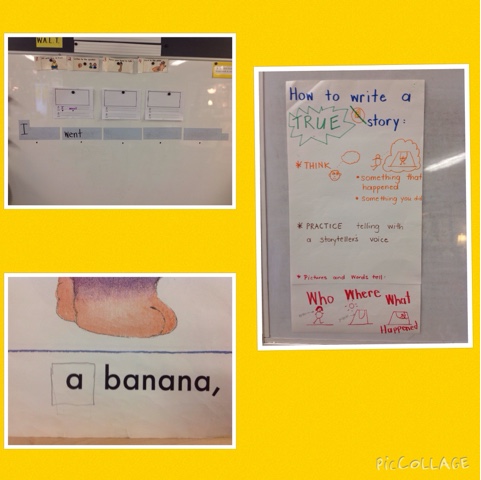Learning to read and write the names of our classmates and teachers is a starting point for learning to read and write this year. We can now recognize whose name begins with a particular sound and sort names by letters, vowels, and initial sounds. We are beginning to look for spelling patterns in names and apply that knowledge to spelling more words.
Young children love seeing photos of themselves and their friends in class projects. Over the last two months we have made several class books with each child contributing at least one page to the overall structure of the book. We have modeled our books after exemplary published texts. For example, we made our own version of Eric Carle's The Very Hungry Caterpillar and Dr. Seuss's Ten Apples Up On Top. In each book we placed a photo of the classmate who wrote that particular page. In our version of the Sesame Street book, A, My Name is Alice, each child wrote about what they liked to eat, choosing a food that began with the same initial sound as their name. For example, Charlie likes to eat Cherries and Paxton likes to eat Pizza. Every morning after snack our class loves to gather these books on the floor and read them together, smiling and giggling at each other as well as learning to read the words and practicing the reading behaviors we are learning in Readers Workshop.
In mid October we created a teacher version of A, My Name is Alice to help us learn the names of familiar adults at PPS beyond those in our own classroom. This not only supported our work with letters and sounds, but also helped us learn the names of almost twenty adults our class interacts with during any given week. Knowing someone's name a little bit about them is essential to building a sense of belonging and community.
We asked each teacher to complete a page in the book and think creatively about what food they like to eat that begins with the same initial sound as their name. Everyone was quite creative as they used alliteration to describe their food. For example, Mrs. Gamache wrote that she likes to eat "Goulash Garnished with Garlic Galore" and Ms. Millham likes to eat "Mushy Marshmallow Muffins."
We put the pages of both name books into a short video and presented it at Friday Whole School Meeting. To begin our presentation each child spoke into the microphone in front of the student body and introduced themselves and named the first sound in their name. Despite some technical difficulties in playing the video online that morning, everyone was able to see the video later in their classrooms. I was so proud of our class for being the first class to make a Whole School Meeting presentation and use the microphone to speak in front of a large group. They did a great job! Since the book contains photos and names of our classmates and teachers, I won't publish the book video here. I will send parents an email with the video link to view the book. Here are some other ways we have used names to learn about letters and sounds.
Names cards to sign in for attendance... name posters... name bottles for spelling names.
We are fortunate to have two classmates whose names begin with Ch, giving us a springboard for learning common sound chunks. Charlie and Chelsea's names can be seen our our word wall so that children can search for how to spell a classmate's name along with sight words we are learning to read and write. To learn familiar sound chunks we sing along with HeidiSongs, learning a short, catchy song lyric that helps us when we go to write the chunk.
Chrysanthemum, but by Kevin Henkes helped us learn the importance of owning our own name and the pride of being who we are in this world. We illustrated the teacher pages in the our alphabet book.
Some still photos as we presented at Friday Whole School Meeting!































